Highly Responsive and Self-Powered Photodetector Based on PtSe2/MoS2 Heterostructure
Abstract
1. Introduction
2. Results and Discussion
3. Materials and Methods
3.1. Fabrication of PtSe2/MoS2 Heterostructure Photodetector
3.2. Characterization of PtSe2/MoS2 Heterostructure
4. Conclusions
Supplementary Materials
Author Contributions
Funding
Institutional Review Board Statement
Informed Consent Statement
Data Availability Statement
Conflicts of Interest
References
- Konstantatos, G.; Sargent, E.H. Nanostructured Materials for Photon Detection. Nat. Nanotechnol. 2010, 5, 391–400. [Google Scholar] [CrossRef] [PubMed]
- Wu, Y.L.; Fukuda, K.; Yokota, T.; Someya, T. A Highly Responsive Organic Image Sensor Based on a Two-Terminal Organic Photodetector with Photomultiplication. Adv. Mater. 2019, 31, 1903687. [Google Scholar] [CrossRef] [PubMed]
- Rogalski, A. Infrared Detectors: Status and Trends. Prog. Quantum Electron. 2003, 27, 59–210. [Google Scholar] [CrossRef]
- Gui, T.; Xia, X.; Wei, B.; Zhang, J.; Zhang, K.; Li, Y.; Chen, W.; Yu, W.; Cui, N.; Mu, H. In-Situ Fabrication of PtSe2/MoS2 Van der Waals Heterojunction for Self-Powered and Broadband Photodetector. Mater. Des. 2024, 238, 112722. [Google Scholar] [CrossRef]
- Yang, Z.B.; Guo, J.X.; Li, H.R.; Du, X.N.; Zhao, Y.N.; Chen, H.S.; Chen, W.W.; Zhang, Y. Large-Scale Synthesis of Two-Dimensional Indium Telluride Films for Broadband Photodetectors. Mater. Des. 2023, 233, 112218. [Google Scholar] [CrossRef]
- Manzeli, S.; Ovchinnikov, D.; Pasquier, D.; Yazyev, O.V.; Kis, A. 2D Transition Metal Dichalcogenides. Nat. Rev. Mater. 2017, 2, 17033. [Google Scholar] [CrossRef]
- Bullock, J.; Amani, M.; Cho, J.; Chen, Y.-Z.; Ahn, G.H.; Adinolfi, V.; Shrestha, V.R.; Gao, Y.; Crozier, K.B.; Chueh, Y.-L. Polarization-Resolved Black Phosphorus/Molybdenum Disulfide Mid-Wave Infrared Photodiodes with High Detectivity at Room Temperature. Nat. Photonics 2018, 12, 601–607. [Google Scholar] [CrossRef]
- Yang, Z.; Hao, J.; Yuan, S.; Lin, S.; Yau, H.M.; Dai, J.; Lau, S.P. Field-Effect Transistors Based on Amorphous Black Phosphorus Ultrathin Films by Pulsed Laser Deposition. Adv. Mater. 2015, 27, 3748–3754. [Google Scholar] [CrossRef]
- Li, H.; Yang, Z. Recent Progress in Synthesis and Photonic Applications of Two-Dimensional Bismuthene. Appl. Sci. 2023, 13, 6885. [Google Scholar] [CrossRef]
- Chhowalla, M.; Liu, Z.; Zhang, H. Two-Dimensional Transition Metal Dichalcogenide (TMD) Nanosheets. Chem. Soc. Rev. 2015, 44, 2584–2586. [Google Scholar] [CrossRef]
- Mak, K.F.; Shan, J. Photonics and Optoelectronics of 2D Semiconductor Transition Metal Dichalcogenides. Nat. Photonics 2016, 10, 216–226. [Google Scholar] [CrossRef]
- Wang, B.; Yuan, J.; Che, M.; Liu, M.; Zou, Y.; An, J.; Tan, F.; Shi, Y.; Zhang, N.; Qi, L. High-Performance Broadband Photodetector Based on PtSe2/MoS2 Heterojunction from Visible to Near-Infrared Region. Sci. China Inf. Sci. 2024, 67, 132401. [Google Scholar] [CrossRef]
- Venkata Subbaiah, Y.; Saji, K.; Tiwari, A. Atomically Thin MoS2: A Versatile Nongraphene 2D Material. Adv. Funct. Mater. 2016, 26, 2046–2069. [Google Scholar] [CrossRef]
- Xie, Y.; Zhang, B.; Wang, S.; Wang, D.; Wang, A.; Wang, Z.; Yu, H.; Zhang, H.; Chen, Y.; Zhao, M. Ultrabroadband MoS2 Photodetector with Spectral Response From 445 to 2717 nm. Adv. Mater. 2017, 29, 1605972. [Google Scholar] [CrossRef] [PubMed]
- Wang, G.; Wang, Z.; McEvoy, N.; Fan, P.; Blau, W.J. Layered PtSe2 for Sensing, Photonic, and (Opto-) Electronic Applications. Adv. Mater. 2021, 33, 2004070. [Google Scholar] [CrossRef]
- Xu, H.; Zhang, H.; Liu, Y.; Zhang, S.; Sun, Y.; Guo, Z.; Sheng, Y.; Wang, X.; Luo, C.; Wu, X. Controlled Doping of Wafer-Scale PtSe2 Films for Device Application. Adv. Funct. Mater. 2019, 29, 1805614. [Google Scholar] [CrossRef]
- Ye, P.; Xiao, H.; Zhu, Q.; Kong, Y.; Tang, Y.; Xu, M. Si-CMOS-Compatible 2D PtSe2-Based Self-Driven Photodetector with Ultrahigh Responsivity and Specific Detectivity. Sci. China. Mater. 2023, 66, 193–201. [Google Scholar] [CrossRef]
- Zhao, Y.; Qiao, J.; Yu, Z.; Yu, P.; Xu, K.; Lau, S.P.; Zhou, W.; Liu, Z.; Wang, X.; Ji, W. High-Electron-Mobility and Air-Stable 2D Layered PtSe2 FETs. Adv. Mater. 2017, 29, 1604230. [Google Scholar] [CrossRef]
- Liu, J.; Xia, F.; Xiao, D.; Garcia de Abajo, F.J.; Sun, D. Semimetals for High-Performance Photodetection. Nat. Mater. 2020, 19, 830–837. [Google Scholar] [CrossRef]
- Rao, G.F.; Wang, X.P.; Wang, Y.; Wangyang, P.H.; Yan, C.Y.; Chu, J.W.; Xue, L.X.; Gong, C.H.; Huang, J.W.; Xiong, J.; et al. Two-Dimensional Heterostructure Promoted Infrared Photodetection Devices. Infomat 2019, 1, 272–288. [Google Scholar] [CrossRef]
- Xu, H.; Han, X.; Dai, X.; Liu, W.; Wu, J.; Zhu, J.; Kim, D.; Zou, G.; Sablon, K.A.; Sergeev, A. High Detectivity and Transparent Few-Layer MoS2/Glassy-Graphene Heterostructure Photodetectors. Adv. Mater. 2018, 30, 1706561. [Google Scholar] [CrossRef]
- Tao, L.; Chen, Z.; Li, X.; Yan, K.; Xu, J.-B. Hybrid Graphene Tunneling Photoconductor with Interface Engineering Towards Fast Photoresponse and High Responsivity. Npj 2D Mater. Appl. 2017, 1, 19. [Google Scholar] [CrossRef]
- Chang, K.E.; Kim, C.; Yoo, T.J.; Kwon, M.G.; Heo, S.; Kim, S.Y.; Hyun, Y.; Yoo, J.I.; Ko, H.C.; Lee, B.H. High-Responsivity Near-Infrared Photodetector Using Gate-Modulated Graphene/Germanium Schottky Junction. Adv. Electron. Mater. 2019, 5, 1800957. [Google Scholar] [CrossRef]
- Wang, G.C.; Sun, Y.; Yang, Z.; Lu, W.X.; Chen, S.; Zhang, X.H.; Ma, H.Q.; Sun, T.Y.; Huo, P.P.; Cui, X.Y.; et al. Near-Ideal Schottky Junction Photodetectors Based on Semimetal-Semiconductor Van der Waals Heterostructures. Adv. Funct. Mater. 2024. [Google Scholar] [CrossRef]
- Sam, R.T.; Umakoshi, T.; Verma, P. Probing Stacking Configurations In a Few Layered MoS2 by Low Frequency Raman Spectroscopy. Sci. Rep. 2020, 10, 21227. [Google Scholar] [CrossRef]
- Tharrault, M.; Desgué, E.; Carisetti, D.; Plaçais, B.; Voisin, C.; Legagneux, P.; Baudin, E. Raman Spectroscopy of Monolayer to Bulk PtSe2 Exfoliated Crystals. 2D Mater. 2024, 11, 025011. [Google Scholar] [CrossRef]
- Su, W.-J.; Chang, H.-C.; Shih, Y.-T.; Wang, Y.-P.; Hsu, H.-P.; Huang, Y.-S.; Lee, K.-Y. Two Dimensional MoS2/Graphene PN Heterojunction Diode: Fabrication and Electronic Characteristics. J. Alloys Compd. 2016, 671, 276–282. [Google Scholar] [CrossRef]
- Ji, J.; Zhou, Y.; Zhou, B.; Desgué, E.; Legagneux, P.; Jepsen, P.U.; Bøggild, P. Probing Carrier Dynamics in Large-Scale MBE-Grown PtSe2 Films by Terahertz Spectroscopy. ACS Appl. Mater. Interfaces 2023, 15, 51319–51329. [Google Scholar] [CrossRef]
- Tongay, S.; Fan, W.; Kang, J.; Park, J.; Koldemir, U.; Suh, J.; Narang, D.S.; Liu, K.; Ji, J.; Li, J. Tuning Interlayer Coupling in Large-Area Heterostructures with CVD-Grown MoS2 and WS2 Monolayers. Nano Lett. 2014, 14, 3185–3190. [Google Scholar] [CrossRef]
- Wang, W.; Meng, Y.; Wang, W.; Zhang, Z.; Xie, P.; Lai, Z.; Bu, X.; Li, Y.; Liu, C.; Yang, Z. Highly Efficient Full Van der Waals 1D P-Te/2D N-Bi2O2Se Heterodiodes with Nanoscale Ultra-Photosensitive Channels. Adv. Funct. Mater. 2022, 32, 2203003. [Google Scholar] [CrossRef]
- Song, Y.; Li, M.; Chen, J.; Du, Y.; Qin, Q.; Du, Z.; Zou, F.; Ma, X.; Li, L.; Li, G. High-Performance Photodetector Based on the ReSe2/PtSe2 Van der Waals Heterojunction. ACS Appl. Electron. Mater. 2023, 5, 2748–2757. [Google Scholar] [CrossRef]
- Qiao, H.; Huang, Z.; Ren, X.; Liu, S.; Zhang, Y.; Qi, X.; Zhang, H. Self-Powered Photodetectors Based on 2D Materials. Adv. Opt. Mater. 2020, 8, 1900765. [Google Scholar] [CrossRef]
- Sun, H.; Lei, T.; Tian, W.; Cao, F.; Xiong, J.; Li, L. Self-Powered, Flexible, and Solution-Processable Perovskite Photodetector Based on Low-Cost Carbon Cloth. Small 2017, 13, 1701042. [Google Scholar] [CrossRef]
- Zeng, L.H.; Lin, S.H.; Li, Z.J.; Zhang, Z.X.; Zhang, T.F.; Xie, C.; Mak, C.H.; Chai, Y.; Lau, S.P.; Luo, L.B. Fast, Self-Driven, Air-Stable, and Broadband Photodetector Based on Vertically Aligned PtSe2/GaAs heterojunction. Adv. Funct. Mater. 2018, 28, 1705970. [Google Scholar] [CrossRef]
- Wang, Y.; Huang, X.; Wu, D.; Zhuo, R.; Wu, E.; Jia, C.; Shi, Z.; Xu, T.; Tian, Y.; Li, X. A Room-Temperature Near-Infrared Photodetector Based on a MoS2/CdTe P–N Heterojunction with a Broadband Response up to 1700 nm. J. Mater. Chem. C 2018, 6, 4861–4865. [Google Scholar] [CrossRef]
- Wu, D.; Wang, Y.; Zeng, L.; Jia, C.; Wu, E.; Xu, T.; Shi, Z.; Tian, Y.; Li, X.; Tsang, Y.H. Design of 2D layered PtSe2 Heterojunction for the High-Performance, Room-Temperature, Broadband, Infrared Photodetector. ACS Photonics 2018, 5, 3820–3827. [Google Scholar] [CrossRef]
- Kong, W.-Y.; Wu, G.-A.; Wang, K.-Y.; Zhang, T.-F.; Zou, Y.-F.; Wang, D.-D.; Luo, L.-B. Graphene-β-Ga2O3 heterojunction for highly sensitive deep UV photodetector application. Adv. Mater. 2016, 28, 10725–10731. [Google Scholar] [CrossRef]
- Zhang, K.; Fang, X.; Wang, Y.; Wan, Y.; Song, Q.; Zhai, W.; Li, Y.; Ran, G.; Ye, Y.; Dai, L. Ultrasensitive Near-Infrared Photodetectors Based on a Graphene–MoTe2–Graphene Vertical Van der Waals Heterostructure. ACS Appl. Mater. Interfaces 2017, 9, 5392–5398. [Google Scholar] [CrossRef]
- Zhang, X.; Li, J.; Ma, Z.; Zhang, J.; Leng, B.; Liu, B. Design and Integration of a Layered MoS2/GaN Van Der Waals Heterostructure For Wide Spectral Detection and Enhanced Photoresponse. ACS Appl. Mater. Interfaces 2020, 12, 47721–47728. [Google Scholar] [CrossRef]
- Tsai, D.-S.; Liu, K.-K.; Lien, D.-H.; Tsai, M.-L.; Kang, C.-F.; Lin, C.-A.; Li, L.-J.; He, J.-H. Few-Layer MoS2 With High Broadband Photogain and Fast Optical Switching for Use in Harsh environments. ACS Nano 2013, 7, 3905–3911. [Google Scholar] [CrossRef]
- Wang, F.; Zhang, T.; Xie, R.; Wang, Z.; Hu, W. How to Characterize Figures of Merit of Two-Dimensional Photodetectors. Nat. Commun. 2023, 14, 2224. [Google Scholar] [CrossRef]
- Lee, J.; Duong, N.T.; Bang, S.; Park, C.; Nguyen, D.A.; Jeon, H.; Jang, J.; Oh, H.M.; Jeong, M.S. Modulation of Junction Modes in SnSe2/MoTe2 Broken-Gap Van der Waals Heterostructure For Multifunctional Devices. Nano Lett. 2020, 20, 2370–2377. [Google Scholar] [CrossRef]
- Lan, C.; Li, C.; Wang, S.; He, T.; Jiao, T.; Wei, D.; Jing, W.; Li, L.; Liu, Y. Zener Tunneling and Photoresponse of a WS2/Si Van der Waals Heterojunction. ACS Appl. Mater. 2016, 8, 18375–18382. [Google Scholar] [CrossRef]
- Wu, W.; Zhang, Q.; Zhou, X.; Li, L.; Su, J.; Wang, F.; Zhai, T. Self-Powered Photovoltaic Photodetector Established on Lateral Monolayer MoS2-WS2 Heterostructures. Nano Energy 2018, 51, 45–53. [Google Scholar] [CrossRef]
- Wang, J.; Han, J.Y.; Chen, X.Q.; Wang, X.R. Design Strategies for Two-Dimensional Material Photodetectors to Enhance Device Performance. Infomat 2019, 1, 33–53. [Google Scholar] [CrossRef]
- Jin, H.J.; Park, C.; Lee, K.J.; Shin, G.H.; Choi, S.Y. Ultrasensitive WSe2/α-In2Se3 NIR Photodetector Based on Ferroelectric Gating Effect. Adv. Mater. Technol. 2021, 6, 2100494. [Google Scholar] [CrossRef]
- Islam, A.; Lee, J.; Feng, P.X.-L. Atomic Layer GaSe/MoS2 Van der Waals Heterostructure Photodiodes with Low Noise and Large Dynamic Range. ACS Photonics 2018, 5, 2693–2700. [Google Scholar] [CrossRef]
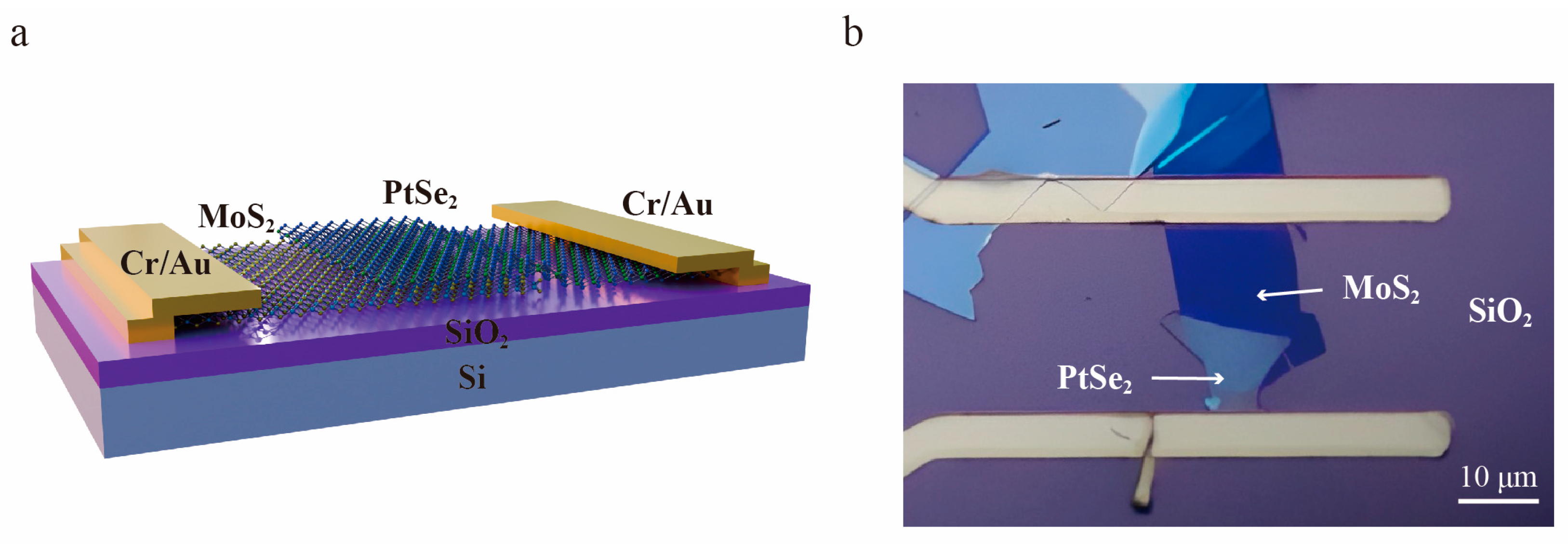
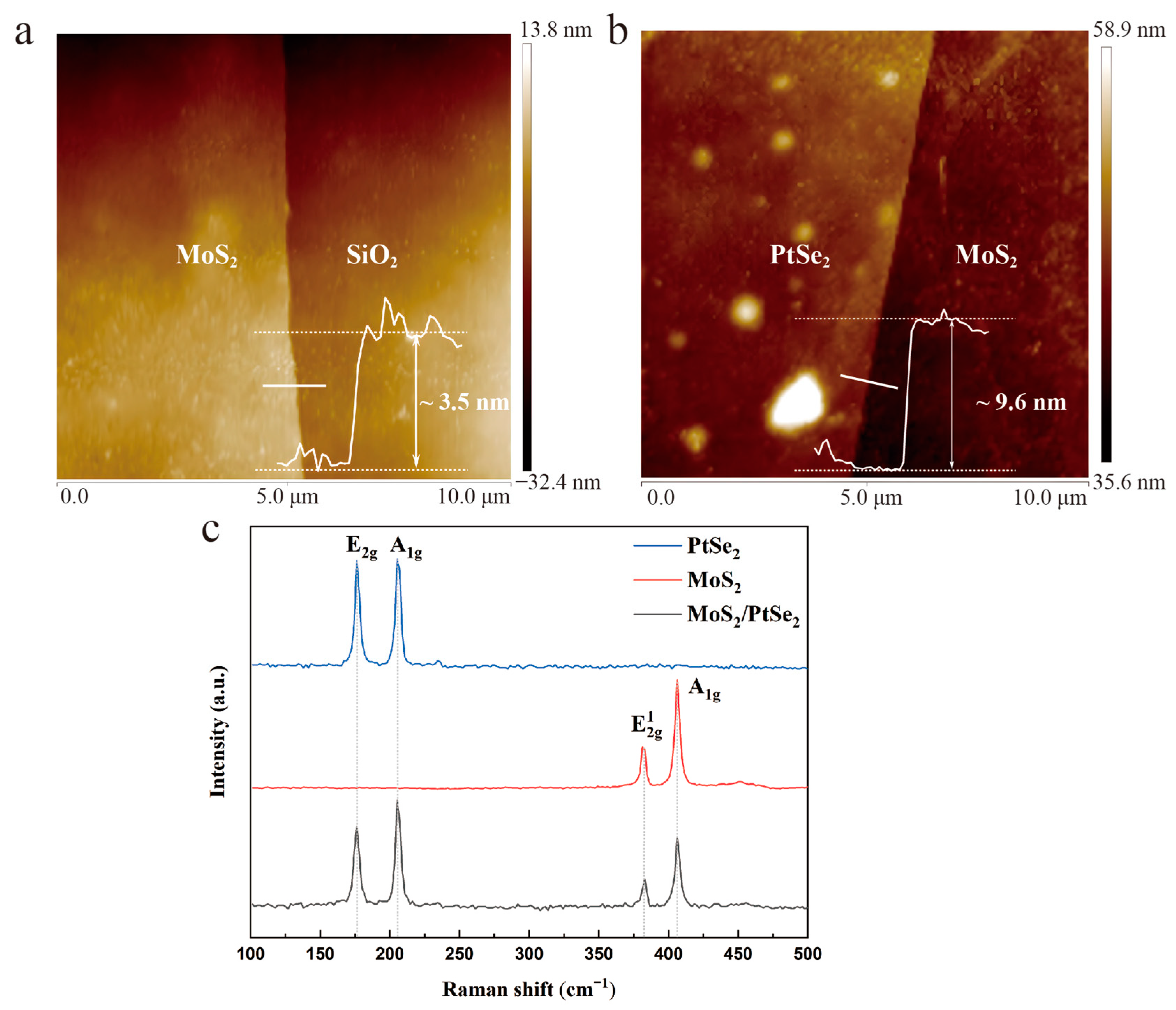

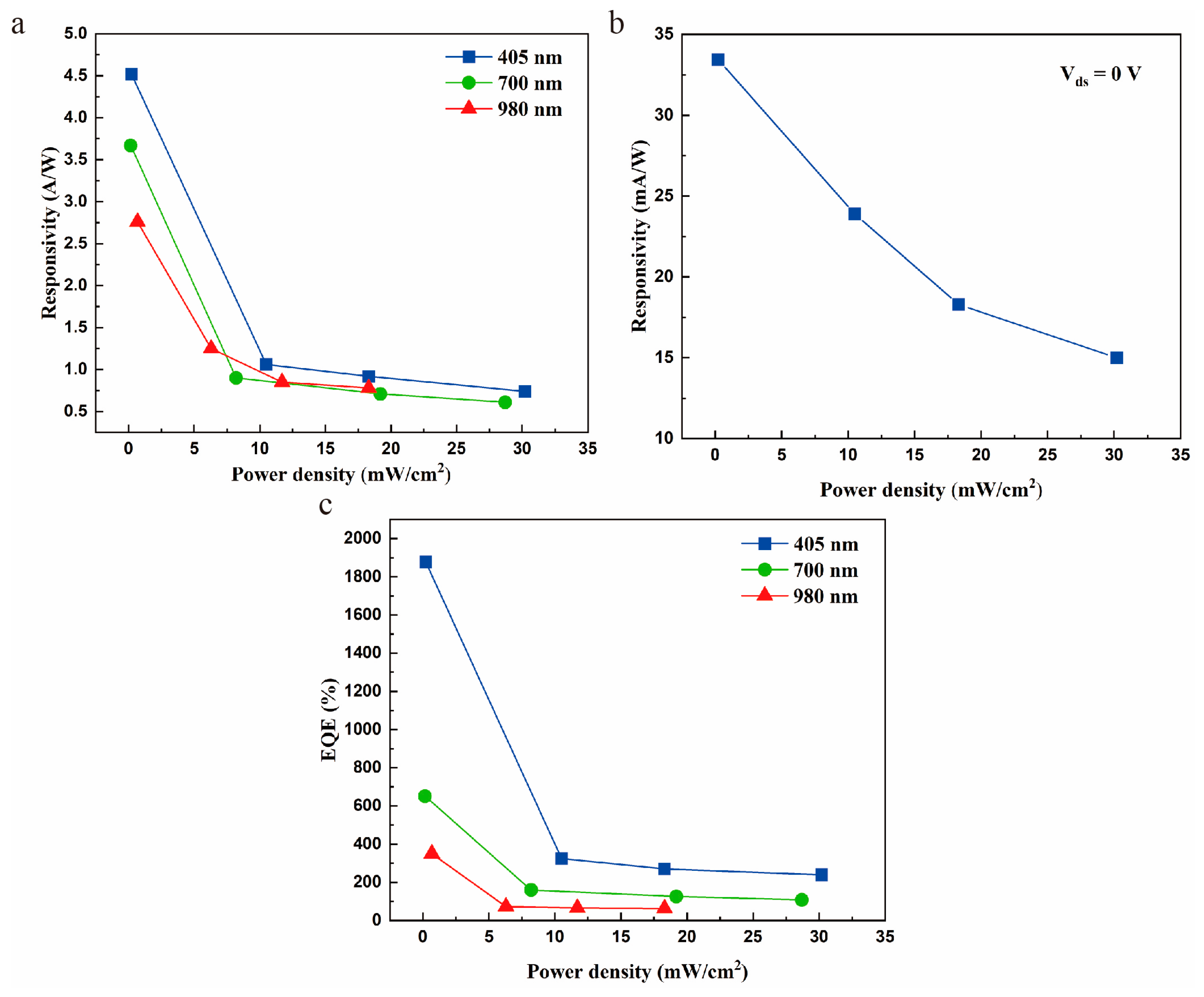
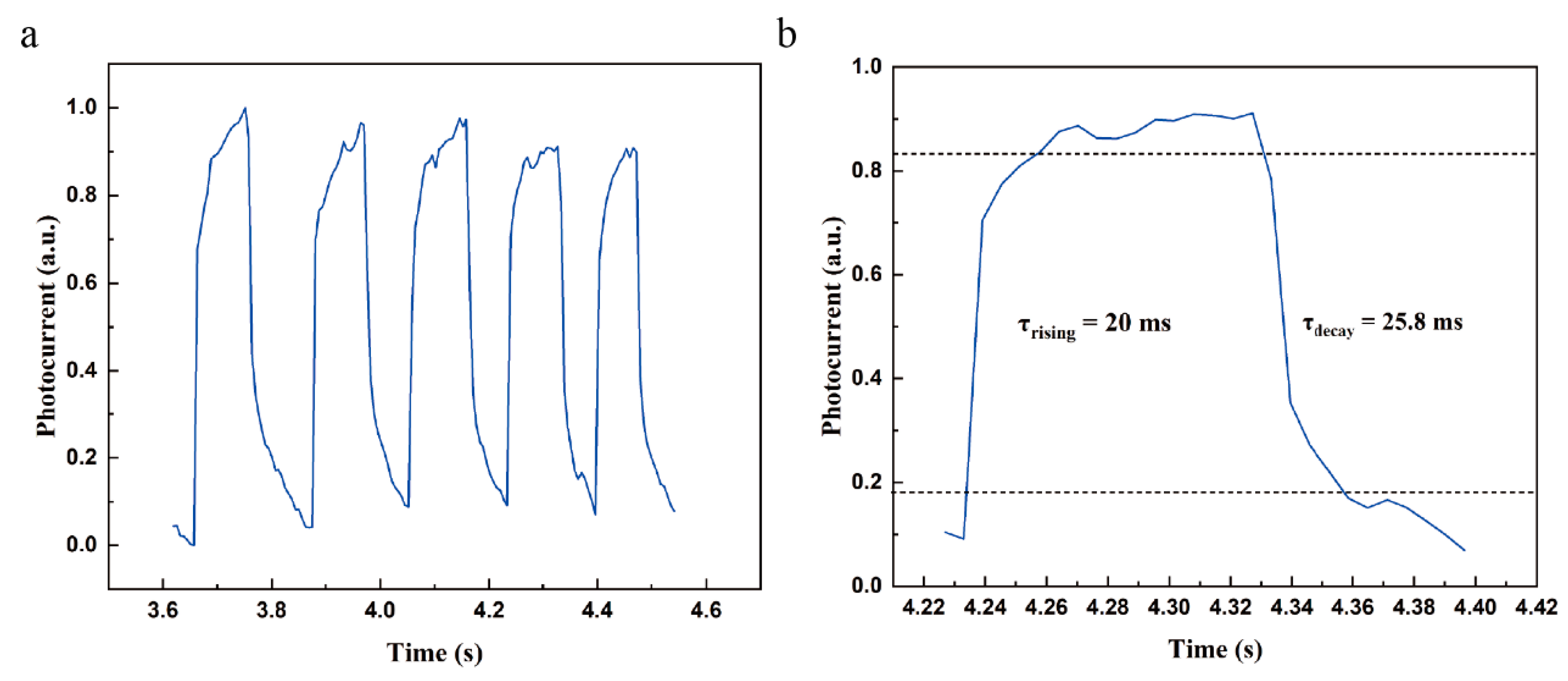
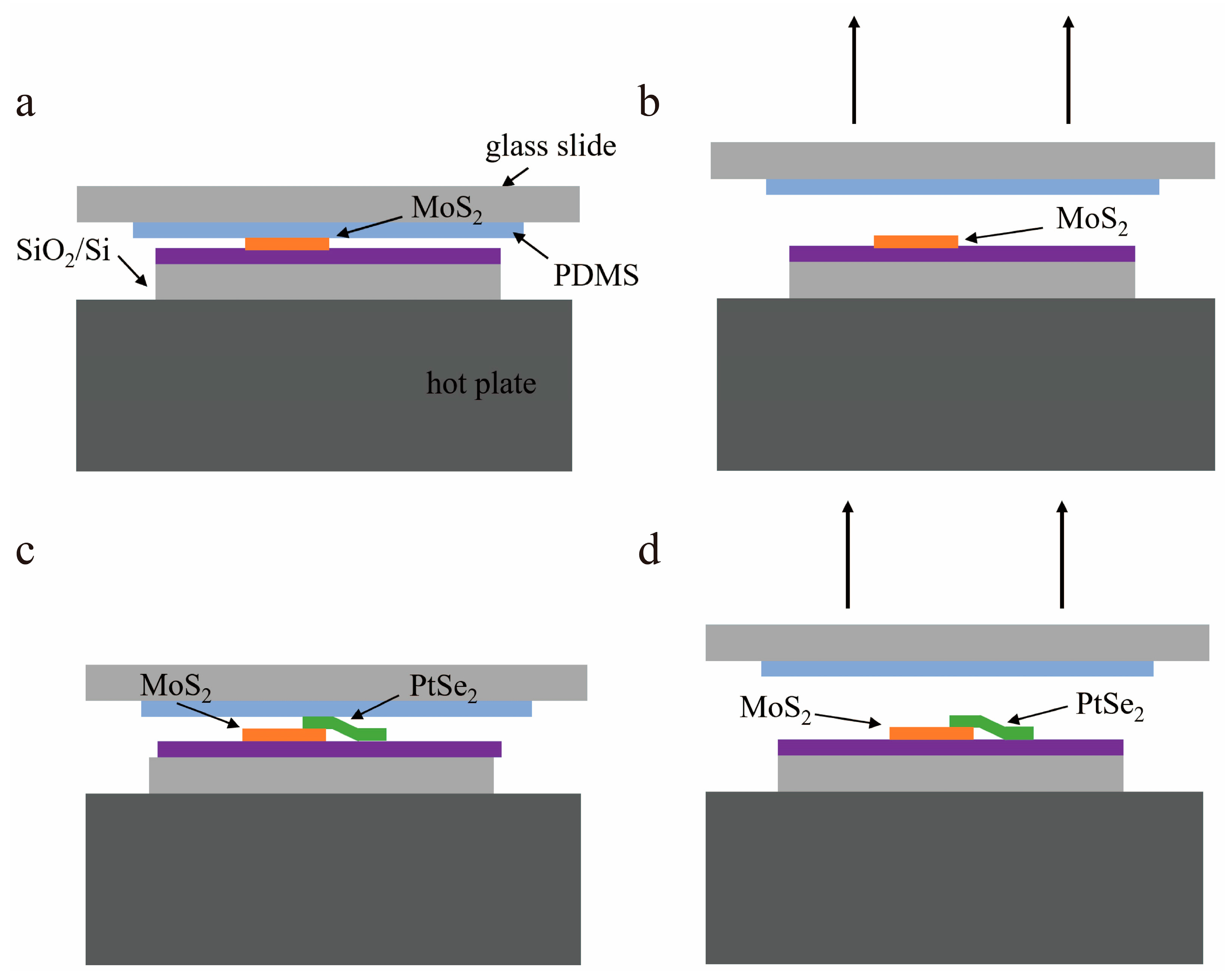
Disclaimer/Publisher’s Note: The statements, opinions and data contained in all publications are solely those of the individual author(s) and contributor(s) and not of MDPI and/or the editor(s). MDPI and/or the editor(s) disclaim responsibility for any injury to people or property resulting from any ideas, methods, instructions or products referred to in the content. |
© 2024 by the authors. Licensee MDPI, Basel, Switzerland. This article is an open access article distributed under the terms and conditions of the Creative Commons Attribution (CC BY) license (https://creativecommons.org/licenses/by/4.0/).
Share and Cite
Li, H.; Yang, Z. Highly Responsive and Self-Powered Photodetector Based on PtSe2/MoS2 Heterostructure. Molecules 2024, 29, 2553. https://doi.org/10.3390/molecules29112553
Li H, Yang Z. Highly Responsive and Self-Powered Photodetector Based on PtSe2/MoS2 Heterostructure. Molecules. 2024; 29(11):2553. https://doi.org/10.3390/molecules29112553
Chicago/Turabian StyleLi, Haoran, and Zhibin Yang. 2024. "Highly Responsive and Self-Powered Photodetector Based on PtSe2/MoS2 Heterostructure" Molecules 29, no. 11: 2553. https://doi.org/10.3390/molecules29112553
APA StyleLi, H., & Yang, Z. (2024). Highly Responsive and Self-Powered Photodetector Based on PtSe2/MoS2 Heterostructure. Molecules, 29(11), 2553. https://doi.org/10.3390/molecules29112553








